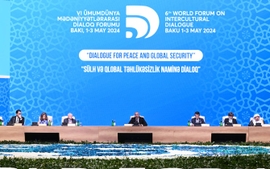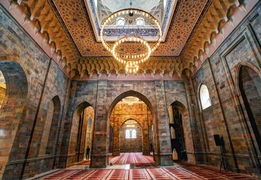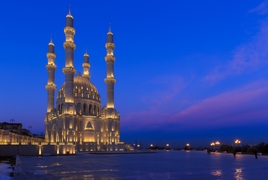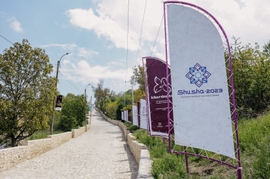More than 400 monuments representing the cultural and religious heritage of Azerbaijan have been destroyed by Armenia in the once occupied Karabakh region.
"Almost all historical, cultural and religious monuments were completely destroyed during the period of occupation. As of today, the Ministry of Culture of Azerbaijan has identified more than 400 monuments that have been destroyed in the liberated territories. The total number of the monuments in these territories is up to 3000. Cultural and religious property belonging to Azerbaijan has been looted, desecrated, altered and illegally exported to Armenia. Twenty-two museums and museum branches with over 100,000 artefacts in the liberated territories have been destroyed,” Azerbaijan’s Foreign Ministry said in a statement issued on the International Day for Monuments and Sites on April 18.
“Artefacts and ancient manuscripts of 13th century Khudavang monastery situated in Kalbajar district, as well as precious artefacts found during illegal archaeological excavations near Shahbulag fortress of Aghdam district were illegally transported to Armenia. Besides that, illegal excavations have been conducted in Azykh cave in Azykh village of Khojavend region," the statement added.
Cultural vandalism by Armenia was common in the once occupied Azerbaijani territories and footage depicting mass destruction of the monuments during the years of occupation went viral after the liberation of the territories. Affected sites included mosques, memorials, museums, statues and more. The city of Aghdam, where the world’s Bread Museum was located, as well as the city of Fuzuli, were completely razed to the ground, now resembling ghost towns.
The Nagorno-Karabakh region and seven surrounding districts of Azerbaijan fell under Armenia's occupation in a war that ensued from the latter's illegal claims to historical Azerbaijani lands. Following the dissolution of the Soviet Union, Armenia launched a full-fledged armed attack on Azerbaijan's Karabakh region. The bloody war in 1991-1994 resulted in Armenia occupying 20 percent of Azerbaijan’s internationally recognized territories – the Nagorno-Karabakh (Daghlig Garabagh) region and seven surrounding districts, including Lachin, Kalbajar, Aghdam, Fuzuli, Jabrayil, Gubadli and Zangilan.
Over 30,000 ethnic Azerbaijanis were killed and one million others were expelled from those lands in a brutal ethnic cleansing policy conducted by Armenia. Although the United Nations Security Council adopted four resolutions in 1993 demanding the immediate withdrawal of the occupying forces from the Azerbaijani lands and the return of internally displaced Azerbaijanis to their ancestral lands, Armenia failed to comply with all four legally binding documents.
The latest outbreak of war in Azerbaijan's Karabakh region started with attacks by Armenia's forces deployed in the occupied Azerbaijani lands on the military positions and civilian settlements of Azerbaijan on September 27 last year. The offensive prompted immediate counter-attack measures by the Azerbaijani forces for pushing back the assault. During 44 days of the war, Azerbaijani forces liberated over 300 settlements, including five major cities from Armenia's occupation. As part of the tripartite ceasefire statement signed by these two countries and Russia on November 10, Armenia returned the occupied Aghdam, Kalbajar and Lachin districts to Azerbaijan by December 1.
According to data compiled by the Ministry of Culture of Azerbaijan, based on the statistics from the early 1990s, some 2,625 monuments were registered in the occupied territories, of which 706 were protected by the state. Hundreds of cultural institutions, including 927 libraries with 4.6 million books, 808 palaces of culture, clubs, and houses of culture, 85 music and art schools, 22 museums and museum branches with more than 100,000 exhibits, 4 art galleries, 4 theaters, 2 concert halls, 8 cultural and recreation parks have been destroyed and looted.
One of the world’s oldest human settlements in the Khojavend district - the Azykh cave; the Shusha State Historical-Architectural Reserve and Govhar Agha Mosque in the same city, Aghdam's Bread Museum and Drama Theater, tens of mosques and cultural buildings in Aghdam, Fuzuli, Jabrayil, Zangilan, Gubadli, and other districts have been targeted by Armenian vandalism, as well. Mosques have been transformed into barns for pigs and cattle during Armenia's occupation of Azerbaijani territories.
Aghdam dubbed as "Hiroshima of the 21st Century" and "Hiroshima of the Caucasus" by international journalists, including prominent French photographer Reza Deghati and media outlets. Azerbaijan's President Ilham Aliyev highlighted the massive destruction in the cities of Aghdam, Fuzuli, Jabrayil, Zangilan, and Gubadli during his visits to the liberated districts.
Azykh cave, the largest prehistoric human settlement that was home to primeval human beings about 350-400 thousand years ago, was subjected to numerous illegal excavations since its occupation by Armenia in 1992. As a result of serial excavations in the cave, dozens of various valuable materials of scientific significance have been discovered and transferred illegally to the museums in Armenia and Western countries. They were introduced as the so-called "traces of ancestors of Armenians".
The most recent vivid proof of Armenia’s massive cultural and environmental vandalism acts was seen in Azerbaijan’s Kalbajar district in November 2020. Before the district’s handover to Azerbaijan under the ceasefire agreement on November 25, Armenians resorted to unprecedented destruction and pillages in Kalbajar by setting houses on fire, chopping down the woods, knocking down the electric poles, and looting historical monuments, including the ancient Khudavang monastery complex. They have ransacked the ancient Albanian monastery complex (referred to as Dadivank by Armenians) to steal sacred items such as church bells and stones, artifacts, and portraits from the monastery. Armenians confessed that they destroyed everything they can "in order not to leave anything to Muslims".
“Smashed graves in a cemetery in Kalbajar region of Nagorno-Karabakh, of Azerbaijanis who were buried here before the 1993 Armenian occupation. Some graves were freshly smashed, seemingly by Armenians who left the area last week after 27 years of occupation,” Amnesty International‘s Senior Crisis Advisor Donatella Rovera said in a Tweet. “During 27 years of occupation all was looted - not a door, nor a window, not a single roof tile was left in the houses of the Azerbaijanis who had to flee in 1993.”
Azerbaijan’s Foreign Ministry interpreted the documented vandalism acts by Armenia as a gross violation of international humanitarian law, including the UNESCO standard-setting instruments, such as the 1954 Hague Convention and its two protocols, as well as the 1970 Convention.
“Regretfully, our appeals to the relevant international organizations to investigate war crimes including the deliberate destruction, misappropriation, alteration of our cultural heritage, as well as illicit removal of our cultural properties by Armenia have been ignored throughout the 30-year occupation. We welcome the interest now being shown in this respect,” reads a statement issued by the ministry.


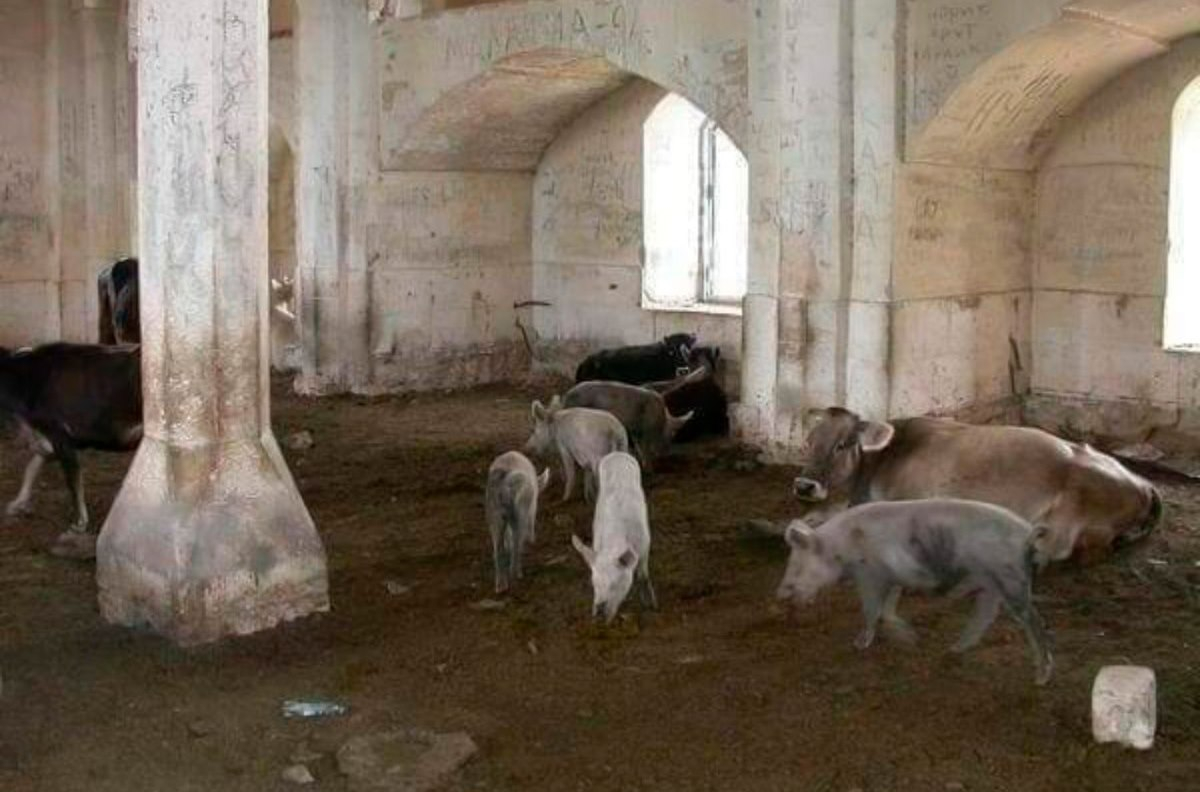




 Russia is set to conduct military exercises to practice the preparation and deployment for use of tactical nuclear weapons in response to the “prov...
Russia is set to conduct military exercises to practice the preparation and deployment for use of tactical nuclear weapons in response to the “prov...
 Iran confirmed that Afghanistan's first transit rail cargo has left for the Razi border crossing, in the country’s northwest region, following a ha...
Iran confirmed that Afghanistan's first transit rail cargo has left for the Razi border crossing, in the country’s northwest region, following a ha...
 The modernized and expanded Georgian segment of the Baku-Tbilisi-Kars (BTK) railway is set to recommence freight operations this month.
The modernized and expanded Georgian segment of the Baku-Tbilisi-Kars (BTK) railway is set to recommence freight operations this month.
